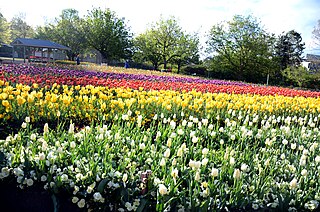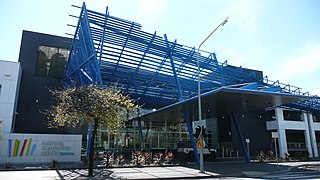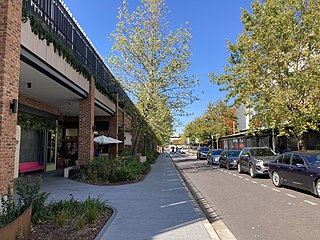
The Australian Capital Territory (ACT), known as the Federal Capital Territory (FCT) until 1938, is a federal territory of Australia. Canberra, the capital city of Australia, is located in this territory. It is located in southeastern Australian mainland as an enclave completely within the state of New South Wales. Founded after Federation as the seat of government for the new nation, the territory hosts the headquarters of all important institutions of the Australian Government.

Canberra is the capital city of Australia. Founded following the federation of the colonies of Australia as the seat of government for the new nation, it is Australia's largest inland city and the eighth-largest Australian city overall. The city is located at the northern end of the Australian Capital Territory at the northern tip of the Australian Alps, the country's highest mountain range. As of June 2022, Canberra's estimated population was 456,692.

The Australian National University (ANU) is a public research university and member of the Group of Eight, located in Canberra, the capital of Australia. Its main campus in Acton encompasses seven teaching and research colleges, in addition to several national academies and institutes.
The University of Canberra (UC) is a public research university with its main campus located in Bruce, Canberra, Australian Capital Territory. The campus is within walking distance of Westfield Belconnen, and 8.7 km (5.4 mi) from Canberra's Civic Centre. UC offers undergraduate and postgraduate courses covering five faculties: Health, Art and Design, Business, Government and Law, Education, and Science and Technology.

The National Museum of Australia, in the national capital Canberra, preserves and interprets Australia's social history, exploring the key issues, people and events that have shaped the nation. It was formally established by the National Museum of Australia Act 1980.

The Royal Australian Mint is the sole producer of all of Australia's circulating coins and is a Commonwealth Government entity operating within the portfolio of the Treasury. The Mint is situated in the Australian federal capital city of Canberra, in Denison St, in the suburb of Deakin. The Mint was opened in 1965 by Prince Philip, Duke of Edinburgh.

Floriade is a flower and entertainment festival held annually in Canberra's Commonwealth Park on the shores of Lake Burley Griffin. It features extensive displays of flowering bulbs with integrated sculptures and other artistic features. Floriade comes from the Latin word floriat, which means to design with flowers.
The Canberra Institute of Technology (CIT) is a vocational education provider in Australia's capital city Canberra, the city is located at the northern end of the Australian Capital Territory. CIT is the largest Technical and Further Education (TAFE) in the Australian Capital Territory. Qualifications offered by CIT range from certificate to degree level. CIT has campuses across Canberra, located in Bruce, Reid, and Fyshwick. CIT also has two learning centres in Tuggeranong Town Centre and Gungahlin which are primarily for students studying via flexible or distance learning. CIT provides a wide range of education and training courses that focus on the skills and knowledge needed for the workplace and further study.

The National Convention Centre Canberra is a convention centre located in Canberra, Australia, which opened in 1989. The Centre is Canberra's largest, purpose-built functions, meetings and events venue, and is managed by InterContinental Hotels Group. It provides a collection of more than 13 spaces over two floors. The Centre hosts sporting events, concerts, trade fairs and meetings. The Royal Theatre, the largest space, can accommodate 2,460; the Exhibition Hall has space for up to 2,000. In 2005, the Centre underwent a $30 million capital upgrade.

Erindale Shopping Centre is a large shopping centre located in the Tuggeranong suburb of Wanniassa in the Canberra region of Australia. It stands on the former site of the Erindale Homestead for which it is named, and comprises 121,815.17 m2 (1,311,207.6 sq ft) of both indoor and outdoor land with 76 stores, restaurants, cafes, and entertainment venues.

The Russell Offices, also referred to as Russell or RO, is a complex of office buildings located in Russell a suburb of Canberra, constituting the seat of the Australian Department of Defence and part of the administrative headquarters of the Australian Defence Force. The land area of the Russell Offices is managed and secured by the National Capital Authority.

The National Film and Sound Archive of Australia (NFSA), known as ScreenSound Australia from 1999 to 2004, is Australia's audiovisual archive, responsible for developing, preserving, maintaining, promoting and providing access to a national collection of film, television, sound, radio, video games, new media, and related documents and artefacts. The collection ranges from works created in the late nineteenth century when the recorded sound and film industries were in their infancy, to those made in the present day.

The John Curtin School of Medical Research (JCSMR) is an Australian multidisciplinary translational medical research institute and postgraduate education centre that forms part of the Australian National University (ANU) in Canberra. The school was founded in 1948 as a result of the vision of Nobel Laureate Sir Howard Florey and was named in honour of Australia's World War II Prime Minister John Curtin, who had died in office a few years earlier.

The ANU School of Music is a school in the Research School of Humanities and the Arts, which forms part of the College of Arts and Social Sciences of the Australian National University. It consists of four buildings, including the main School of Music building – which contains Llewellyn Hall – and the Peter Karmel Building.

Massimiliano Fuksas is an Italian architect. He is the head of Studio Fuksas in partnership with his wife, Doriana Mandrelli Fuksas, with offices in Rome, Paris and Shenzhen.

The ANU College of Law is the law school at the Australian National University and one of the seven academic Colleges of the ANU. It is located in Canberra, the capital of Australia. This provides the College with opportunities to connect with the work of the Parliament of Australia, the High Court of Australia, the departments and agencies of the Federal Government, as well as the local ACT law-making institutions – the Legislative Assembly and the ACT courts.

The Canberra Times is a daily newspaper in Canberra, Australia, which is published by Australian Community Media. It was founded in 1926, and has changed ownership and format several times.
Guida Moseley Brown Architects is an Australian international architectural, interior and urban design firm based in Canberra. The firm specializes in major public buildings, educational and research facilities, large scale residential developments, amongst other commercial and corporate projects.

The Big Powerful Owl is a sculpture 8 m (26 ft) tall, designed by Bruce Armstrong and located in the Belconnen District of Canberra, Australia; it depicts a powerful owl.
















